#the machine herald ;; gallery
Explore tagged Tumblr posts
Text
more studio wall doodles to fill the void of finishing my project


#sailors art content#studio wall gallery#arcane#league of legends#machine herald viktor#viktor arcane#arthur morgan#rdr2#rdr2 fanart#jayce talis#jayce giopara#you have to guess which
53 notes
·
View notes
Text

self-indulgent gift art for myself and @sfaradi of Viktor and Salome in domestic bliss, because after the lives they've had, they deserve it!
6 notes
·
View notes
Text
“In still and moving pictures, Wong’s presence appears firm and declarative, but in words we find her troubled by what her image has been made to say. To let Wong “speak for herself,” Huang often pulls quotes verbatim from interviews and much of her own published writing—most notably from a series of travel dispatches commissioned by the New York Herald Tribune before she left for China. She seems unsettled by the phantom entourage of her varied personae, searching the looks of untold others for a way of looking at herself. “I seemed suddenly to be standing at one side watching myself with complete detachment,” she told the Los Angeles Times of that early jaunt in Berlin. “Up to that time I had been more of an American flapper than Chinese.” When she landed in her paternal hometown of Taishan, the locals received her with disbelief: “Many women could not believe I really existed,” she later relayed, “they had seen me on the screen but they thought I was simply a picture invented by a machine.” But the Wong whose voice I want to hear the most—older and wearier, I imagine, made sharper by retrospect—never appears. The quotations trail off after 1936 and end in 1943, with some of her notes on Chinese cooking. Huang crams the last twenty years of her life into just three of the book’s forty chapters, careening through her career’s postwar stasis, her brief stint in television, and her quiet end as a dipsomaniac landlord in Santa Monica.
While reading, I catch myself collecting mentions of Wong’s birth name. It sneaks on-screen in Piccadilly, when “the heroine Shosho signs Anna May’s Chinese name as if it were her own,” appending her anglicized sign-off with “Wong Liu Tsong” in Chinese script. The calligraphy is awkward and gaping, strokes made by an uncertain hand. Who was in on this, back then? Who looked at the sum of those lines and saw a name, not a piece of chinoiserie? It appears again in 1951, when the soon-defunct DuMont Network cast her as the lead in its television series, The Gallery of Madame Liu-Tsong, but those reels were flung into the East River when the company shuttered. “When I die,” Wong quipped two years before she did, a quote so famous it does not appear in this book, “my epitaph should be: I died a thousand deaths. That was the story of my film career.” But she hardly has a grave, never mind an epitaph—in the epilogue, Huang takes us to Angelus Rosedale Cemetery, where she appears as a single line on a shared tombstone: “Daughter, Liu Tsong.” I look for that name because, like her, I was also born with a different one, and no one has said it in years.”
9 notes
·
View notes
Text
ABOUT: Andrealphus

"Hmm, well this kind of situation is extremely unique. A Goetia has never behaved like this before… But with him alive, we have options, opportunities… Eternity is a long time, my dear. I say we bide our time, and wait for the chance to gain the upper hand."
-
Marquis Andrealphus is a demon within Hell’s aristocracy and a key member of the powerful Ars Goetia, a noble family of Hell. Known for his cold demeanor and calculating mind, Andrealphus is as frigid as the ice he commands. He embodies the meticulousness and elegance of his station, using both magic and influence to climb Hell's complex social hierarchy.
Born into a prestigious lineage, Andrealphus is one of Hell's most prominent social strategists. His mastery of manipulation is unparalleled, and he is feared for his ability to turn any situation to his advantage with mere words. Andrealphus sees relationships and alliances as tools to be wielded in his relentless pursuit of power and influence.
Full Name: Andrealphus Ars Goetia Aliases: The Frost Marquis, Marquis of Ice, The Master of Influence, Andre Species: Demon (Avian-Peacock) Features: White feathers, turquoise eyes and beak, and periwinkle hair. Gender: Male Orientation: Homosexual hc Height: 9 feet (2.7 m) Weight: 437 pounds (198 kg) Affiliation: The Ars Goetia Occupation: Aristocrat, Strategist, Manipulator Powers: Ice Manipulation, Status Manipulation, Mental Manipulation, Hypnosis, Social Influence, Limited Flight, Genius Verses: Affair with Stolas (botanikos), Twin AU where he is named Andras (redemonarc)
HEADCANON: -Academic Genius: Andrealphus has a scholarly streak and is deeply knowledgeable about the history of Hell's nobility, celestial politics, and even ancient magics. He hoards rare tomes in an extensive library, believing knowledge to be power. -Artisan of Ice: His control over ice magic is so precise that he’s an unparalleled sculptor. He creates lifelike ice statues as a form of meditation, many of which are stored in his palace as a personal gallery.
-Despises Wrath Demons: He has a particular disdain for demons from the Wrath ring, viewing their lack of refinement and brute force as a stark contrast to his composed, icy nature. -Freezes with a Touch: When angered, Andrealphus can lower the temperature of a room instantly, creating frost that spreads from his feet or hands without him needing to focus consciously.
-Chills as a Sign of Presence: His arrival is heralded by a sudden drop in temperature and visible condensation, even in Hell's hotter rings, making him an imposing figure wherever he goes. -Aurora Lights: His ice magic sometimes emits soft, shimmering lights, similar to the Northern Lights. This ability makes him stand out during formal gatherings and is a subtle display of dominance.
-Self-Crafted "Crown": His icy appearance is partially intentional; he regularly crafts himself an ice crown or adornments as a symbol of status. The designs change depending on his mood or the occasion. -Mirror of Truth: Andrealphus possesses a magical mirror that reflects not just the physical appearance but also the true nature of those who gaze into it. He uses it to manipulate others by exposing their insecurities.
-Rivalry with Mammon: He sees Mammon’s ostentatious displays of wealth and power as gaudy and unbecoming of nobility, leading to subtle yet sharp public confrontations during Hell’s high-society gatherings. -Reluctant Admirer of Blitzo: Though he'd never admit it, Andrealphus secretly admires Blitzo's brazen attitude and ability to act freely, without the constraints of nobility. This frustrates him to no end.
-Schemer Supreme: Behind the scenes, he manipulates events in Hell's political and social spheres, often setting up others to take the fall for his own machinations. -Octavia: His relationship with Octavia is surprisingly soft. He sees her as the "better" representative of the family bloodline and occasionally sends her small, icy gifts, such as enchanted snowflakes that never melt.
APPEARANCE: Andrealphus presents himself with the grace of a nobleman and the cold beauty of an ice sculpture. His avian features—large, crystalline wings resembling that of an icy peacock—are his most striking trait, along with his sharp eyes that gleam with intelligence and cunning. His clothing is regal and immaculate, typically adorned with icy blues, whites, and silver tones, reflecting his cold nature and elemental abilities.
PERSONALITY: Andrealphus is an aristocrat to the core—poised, composed, and calculating. He values intelligence, refinement, and social status above all else and views emotions as a weakness to be exploited. He maintains a calm and collected exterior, rarely revealing his true thoughts or feelings. Beneath this calm, however, lies a ruthless desire for power, and he is willing to sacrifice anyone or anything to achieve his goals.
While many fear him for his manipulative nature, Andrealphus commands respect within Hell's elite for his unwavering composure and strategic brilliance with many owing him favors. He often seeks to influence or control others from the shadows, viewing direct confrontation as a last resort.
POWERS: Ice Manipulation: Andrealphus can control ice with exceptional precision, creating structures, barriers, and weapons from nothing but frost. His icy magic is known to freeze even the hottest fires in Hell. Social Influence: A master manipulator, Andrealphus can sway the minds of others through charm, coercion, and subtle persuasion, often without them realizing they are being controlled. Status Perception: He has an uncanny ability to perceive social dynamics, power shifts, and weaknesses in his adversaries, making him a formidable political player. Hypnosis: When he spreads his wings, the crystals within his feathers are capable of drawing the eye in hypnotic fashion. Limited flight: His wings are too weak for full flight, but he can do extended jumps and leap up to tree height or use them to glide down.
RELATIONSHIPS: Stella (Sister): Andrealphus is Stella’s brother, and he shares a close, if somewhat strained, relationship with her. He supports her in her vendetta against her husband, Stolas, seeing it as a way to further their family's power.
Stolas (Brother-in-law): Andrealphus holds disdain for Stolas, particularly for Stolas's relationship with the imp Blitzo, which Andrealphus sees as a disgrace to their noble bloodline. He actively works against Stolas to undermine his standing in Hell. Note: In some universes, Andrealphus is engaged in an affair with Stolas, often sneaking out to make out with Stolas during the divorce meetings.
Octavia (Niece): His relationship with Octavia is surprisingly soft. He sees her as the "better" representative of the family bloodline and occasionally sends her small, icy gifts, such as enchanted snowflakes that never melt.
Blitzo: While Andrealphus views Blitzo as beneath him, he recognizes the imp’s influence on Stolas and considers him a nuisance that must be dealt with carefully. He secretly admires Blitzo's brazen attitude and ability to act freely, without the constraints of nobility.
2 notes
·
View notes
Text
The Apocalypses
This is an archive of an essay I wrote on my substack in October 2023.
This month’s newsletter/essay collects my thoughts on the “apocalypse” as dehumanization; it is the ethos of my October group show, Offworlds, with YveYANG Gallery and my painting Beastwoman.
Introduction to The End
The “apocalypse” is an idea coveted and fantasized since humans became humans, stepping out of the primordial water from tiktaalik to monkey to man. Or something like that.
The end of the world has happened over and over again. Every day there is a new catastrophe, and every epoch is defined by the atrocities that have birthed and ended it. Take, for example, the dinosaurs— how much modern humanity wonders about the glint of a scaled beast’s eyes as it looks upon a bright white light, a harbinger of certain doom. Do you think a dinosaur has a sense that it will die? That its lineage will not survive the coming eons? Or does the beast stare at the comet in pure, sublime… unknowingness? These are questions humanity projects onto the beasts because we naturally empathize with death, with fossils, and with bones.
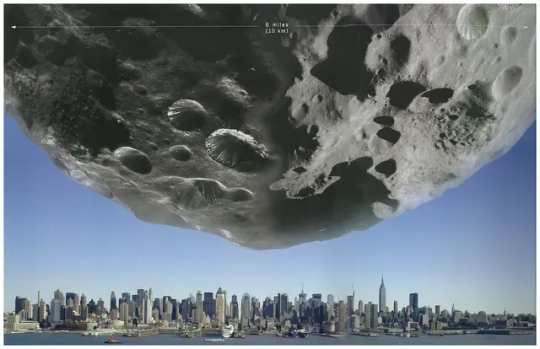
(above): The meteor landed in the Yucatán Peninsula in Mexico over 66 million years ago. This rendition depicts its size against downtown Manhattan.
Another bright white light is featured in another apocalypse, that being the Christian Apocalypse— the bright glow of angels falling from the sky and the cacophony of trumpets heralded the arrival of end times. These details of the Book of Revelations are extremely fascinating, especially if you delve into the story’s great symbolism. For Ancient Christians, the Apocalypse represented the death and oppression of Christianity during the reign of the cruel Emperor Nero; for example, Biblical scholars argue that the Mark of the Beast (666) is actually a code that could be derived through gematria (the system of assigning numerical values to letters). By converting Nero’s name into numbers and then into a sum, it would create the number “666”. This, paired with the Revelations 13:17:
that no man might buy or sell, save he that had the mark or the name of the beast or the number of his name.
In conclusion, the “end of the world” concerns the loss of Humanity and the transformation of the human into the non-human. Some tropes include humans becoming machines, humans being replaced by beasts, or conversely, humans without an Earth or home. This is a perfect segue into discussing my painting Beastwoman.
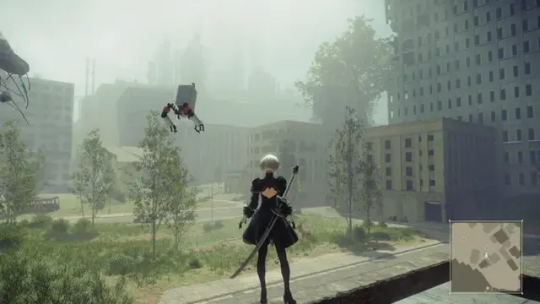
(above): One of my favorite video games, NieR: Automata, is set in a deeply melancholic, far-future post-apocalyptic world where android women fight toy-like machines to preserve the leftovers of humanity. See below for the overworld music for the first area, “City Ruins.”
youtube
Offworlds
Beastwoman is currently on view (through December 2, 2023) at YveYANG Gallery, in Offworlds which is an exhibition exploring the apocalypse from an Asian femme perspective. I highly recommend clicking on the hyperlink to read the press release, as well as acknowledging all the amazing Asian women artists who have worked on this show.
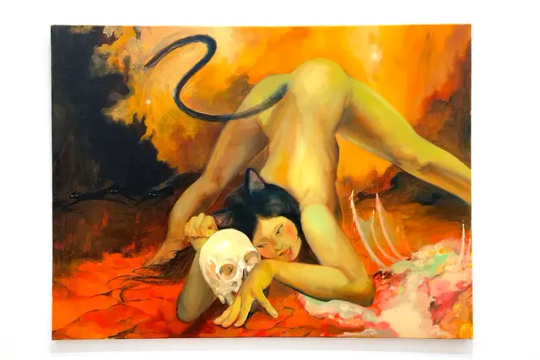
(above): Offworlds is curated by Danni Shen. Beastwoman, oil on canvas, 30” x 40”, 2023.
In creating Beastwoman, I was mainly concerned with the apocalypse as the loss of humanity. Not in a great cataclysmic event, but rather in the appearance of the non-human; I am interested in the “in-between” of man and beast. This notion is deeply political, particularly in the United States.
For white supremacists, the end of the world may be when the “human” (the civilized cis-het white person) becomes the “beast” (the savage non-white and/or queer person). This apocalypse is at the very core of the Great Replacement theory, a fascist belief that miscegenation would cause the white race to be bred out. It is an ideological offspring of the one-drop rule and various scientific racism and eugenicist movements, which historically classified black, indigenous, Asian, and other non-"white” people as animals in a separate genus from the White man. I write this in quotes because it is important to note that white supremacy is a self-defeating, separatist concept; who claims “whiteness” is ever-changing, as even Benjamin Franklin once described Germans as “too swarthy” to immigrate to the United States.
In Beastwoman, I wanted to explore this “in-between.” In my terminally online brain, a non-human form regularly idolized and adored is the “cat girl,” a trope in anime where cute girls spawn cat ears and tails and meow compulsively. They are typically half-girl/half-cat, but maintain the submissiveness and femininity that makes them heavily fetishized in some internet subcultures (which, by extension, often goes hand-in-hand with a fetish for Asian women).

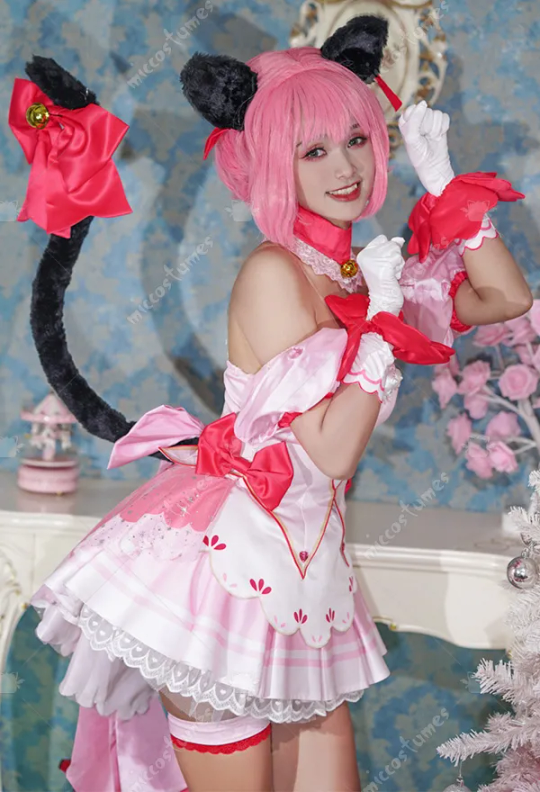
Left: Wikipe-tan, Wikipedia's personification, as a cat girl; Right: A cosplay photo of Ichigo from the anime Tokyo Mew Mew
The reimagining of the cat girl, a soulless, cutesy vessel that has been coopted and sexualized (as many earlier cat girl media being aimed at young girls) for the pleasure of men, into a “beastwoman” is amusing. If she (no longer half-girl/half-cat, but rather half-woman/half-beast) were to embrace her status as an independent Asian woman, then she would be a herald of an apocalypse for the white supremacist. She is no longer submissively and pleasantly vacant, but rather violent, naked, cannibalistic, and carnal. She has ascended from the fetishistic label of a mere “cat-girl,” into claiming agency for her own self— an animalistic and powerful state of a “beastwoman”.
Absurd, but so is the existence of being an Asian woman… so are the threads that hail doomsday. Beastwoman, the name itself, refers to the history of scientific racism, as Asians and other people of color were classified as beastly and inferior; instead of rejecting its inhuman racist descriptor, Beastwoman leans into it and empowers herself through it. If the submissive Asian woman liberated herself to become the bastion of true power, would the world end? Would we be in hell?
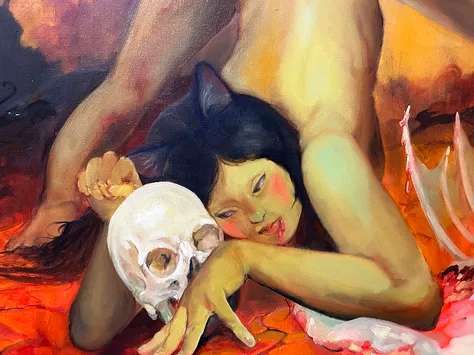
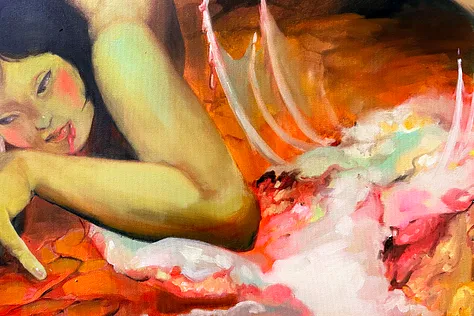

Detail and installation shots.
Acknowledgment
Finally, this statement is regarding the privilege the West (and by extension, myself) has in discussing the apocalypse. For many people, countless real tragedies permeate their land and their children. While some may be able to leave the apocalypse a thing of fantasy or intellectual extrapolation, many do not. It is incredibly important to acknowledge that the crux of the apocalypse (extinction, genocide, loss of land) is a brutal reality. The art we make regarding disaster should be sensitive to these various histories, especially in colonized people and lands. I implore all creators and patrons to be keen on this topic.
6 notes
·
View notes
Text
Luhren - Luhren (WIP)

They are fairly spread out. The city stretches for several miles in either direction. Of course, the main hub is in the center, but smaller clumps are dotted around it.
An industrious city, it has factories popping up here and there in the smaller communities around it. These communities aren't exactly factory towns, but they're not not factory towns either.
Progress oriented. While most of the big hubs for guilds are found in the Wastes, they have branches in Luhren for the factory workers.
Because of this progress-seeking mentality, they're big on the sciences and regularly work with the mages in the Lantern Isles to improve the industries found here.
Pollution is a problem.
86k people
930 years old
Trade/Industry: Textiles, stone, weaponry, steel, varying machines
Shops:
Heralding Front (armory)
Charlotte's Menagerie (mounts and familiars)
Restaurants and Inns:
The Nag's Head Inn
Flowery Foods
Districts:
Highttown - Upper Class/Nobility
Uptown - Shopping District and Middle-Class
Lowtown - Lower Class
University District
Guild District
Notable Locations:
Uptown, their shopping district
Jesob's Gardens
Gallery of Stars, a planetarium
Temples to Ebonel and Kevlek
Post Office/Aviary
College of Engineering
Colosseum
Characters:
Charlotte Fellwater Thistle Flowery King Rephael Calrot Farseer Beral
#legend of lan#legend of lan verse#the legend of lan#legend of lan location#city: luhren#country: luhren#mine#do not use#world building
1 note
·
View note
Text
Mirabelle Jones
Mirabelle Jones (they / them) is a queer, non-binary creative technologist, educator, researcher, and transdisciplinary artist focused on the development of interactive and immersive storytelling technologies, educational activism, and ethical AI practices through a lens of intersectional data feminism. In their practice, they design and develop immersive art installations, biofeedback wearables, educational toolkits, mixed reality sculptures, endurance performances, artist’s books, and AI and machine learning-based artworks. They are a PhD candidate at The University of Copenhagen in the Department of Computer Science within the Human-Centered Computing section exploring ethics and AI through creative critical technical practice. They are an affiliate of metaLAB Harvard. They are the founder and curator of AI Performance Space, an online gallery for performance artists around the world working with artificial intelligence. They are a member of Women in Hardware and The Building Trustworthy AI Working Group of Mozilla Festival.
Jones possesses an MFA in Book Art and Creative Writing from Mills College and a BA in Literature from the University of California, Santa Cruz which informs their narrative-centered creative process. They have taught graduate-level interactive art courses at HackadayU and Codame Art & Tech as well as workshops for metaLAB Harvard, Radiona, Catch: Center for Art, Design, and Technology, Gray Area Foundation for the Arts, and Artsformation among others. Previously, they served as a Senior Designer / Developer of Interactive Technology for the award-winning immersive arts collective Meow Wolf. They are the founder of Art Against Assault, a grassroots initiative encouraging the development of creative works which promote advocacy and raise funds for sexual assault and domestic violence survivor resources. Jones’s works have most recently been featured at Harvard Art Museum, Catch: Center for Art Design and Technology, ATA Gallery, Museum Meermanno, the Center for Performance Research, and the Finnish National Opera and Ballet’s Opera Beyond competition. Their works appear in several collections including the One National Gay & Lesbian Archives and the Center on Contemporary Art’s historic Hear Our Voice (the Women’s March on Washington) collection as well as the special collections libraries of the School of the Art Institute Chicago, Syracuse University, University of California Berkeley, University of North Carolina at Chapel Hill, Mills College, and the University of Northern Texas.
Their performances and visual works have been heralded by the Huffington Post, ArtNet, Ms. Magazine, Techtopia, Ingeniøren, Bustle, ATTN, Refinery29, Mic, Sleek Magazine, Feminist Magazine, Deutsche Welle, Google News, and elsewhere. They have received awards and recognition from the Creative Europe Programme of the European Union, Nordic Summer University, the Pollination Project, the Amplifier Foundation, the KALA Arts Institute Fellowship and the College Book Arts Association. They have been a guest speaker and presenter at arts institutions around the world including MIT, Aalborg University, the University of Gothenburg, School of the Art Institute in Chicago, Rhode Island School of Design, and Maryland Institute College of the Arts. They are a former Artist-in-Residence of Catch: Center for Art, Design, and Technology, Women’s Studio Workshop, KALA Art Institute, Codame Labs, University of Illinois (Unit One), Hive Gallery, and Arts Everywhere at UNC as well as a former Recurser.

MEOW WOLF SENTIENT SLIME
"Working with lead artist Oliver Polzin, I created a design for the interactive lighting of a group of sculptures throughout Meow Wolf Denver known as Sentient Slime. Using a combination of pressure sensors and RFID interactivity, we were able to incorporate visitor interactions with the slime to see if they were friends or enemies of the slime. Each visitor would receive different lighting and sound interactivity depending on their relationship and a digital storytelling layer provided a riddle for visitors to solve as they interacted with slimes throughout the exhibit."




MEOW WOLF FROG EGG GARDEN
"I had the pleasure of collaborating with Emmanuelle John on the lighting and sound interactivity for floor two of the Cosmohedron, the Frog Egg Garden, of Meow Wolf Denver. This gorgeous space is covered floor to ceiling in textures with embedded lighting giving an impression that is one part amphibious and one part extra terrestrial. Being huge fans of accessibility and spaces for people to rest, we included illuminated and cushioned benches next to large dome windows that look out over the enormous illuminated forest Numia by Caity Kennedy. Emmanuelle and I loved the idea of having small hand-sized sculptures that could work as powerful controllers for sound and lighting not only in the interior of the room but throughout Numia. In the end, we came up with six designs for sculptures, some of which started with Emmanuelle modeling them in clay then I transformed them into 3D sculptures using a combination of scanning and modeling from scratch. These models were then printed in a semi-translucent SLA reminiscent of glass using a Formlabs2. We created casings for these sculptures to hold side emitting LEDs and capacitive touch plates. We embedded the sculptures in the benches with the result that when people placed their hands on the sculptures they could control shifts in the lighting and sound as well as “shoot” light out throughout the forest. When all six of the sculptures were activated, a special environment was activated in the room and outside as well. We also created a wheelchair-height 3D printed ear sculpture with an embedded microphone that would pick up sounds in the room and mix them into the sound throughout the room and throughout Numia."

"Artificial Intimacy is a project that considers what happens when you produce non-normative chatbots based on diverse identities. This interactive installation has three parts: a video installation, two graphic wall hangings, and an interactive chatbot sculpture. The video installation consists of two video screens that depict Leslie Foster: a queer black bisexual artist whose works concern race, indigenous concepts, gender and identity, and Gorjeoux Moon: a trans non-binary femme poet whose works concern trauma, addiction, sex, and gender, conversing with chatbot versions of themselves. The chatbots were consensually trained on a dataset based on Foster and Moon’s social media profiles. The second part of the installation, the wall hangings, are made of a semi-translucent mesh in a gradient of mauve and gold. They depict silhouettes of Foster and Moon alongside quotes from the video. The third part of the installation is a 3D-printed interactive chatbot sculpture that allows you to talk to either Foster or Moon’s chatbot in a conversation of your choosing."
"The three parts of the installation combine to help the viewer explore: what happens when LGBTQAI and BIPOC individuals become the basis for chatbots? What non-normative values do the chatbots represent and how are these incorporated? The project interrogates gendered and racialized alternatives to normative voice assistant programs through two individuals while asking: what values are incorporated into voice assistant programs and how do these values manifest? It also considers: can we create digital copies of ourselves based on our data alone? As well as exploring subsequent questions such as: how much data is necessary and of what type to make a realistic replica? Do we prefer these kinds of models to normative chatbot systems? If the data is of us, but not us, what exactly separates us from our data?"
0 notes
Note
viktor and silco fighting over who gets to raise naph: we are literally flirting. this is sooo cute omg. our romantic slash sexual tension is so #goals etc. etc.
naph into the voice recorder: day 7 of my plans to get kidnapped by the chem barons so viktor finally goes scorched-earth on all of zaun. today i am going to televise the enforcers beating me into the earth. wow jayce's hair looks really bad today. the gas pipes have been broken.
you are awesome
“Day 8.” Naph says, into the voice recorder, staring at the ceiling. “Things could be going better.”
They could also be going worse, he reflected. Actually, as far as his actual quality of life went, things were better than they had ever been. If his goal had been to be safe and comfortable, he’d have nailed it. Unfortunately, that was not his goal.
“Silco had another argument with Jayce today.” he continues. “Or– councilor talis. Whatever. He cried. I think he actually cried.”
It had been...weird. Less because Jayce cried. From Viktor’s stories about Jayce, he seemed like the kind of person who did that a lot. Naph had not been surprised by literally anything about meeting Jayce. What had been weird was that Silco had reacted to it. Seemed genuinely concerned by the crying. That was weird. That was not in the plan. The plan was not going well.
"Viktor didn't fight him, either." He says. "They just argued for a bit. Viktor took off his visor at one point and jabbed Silco in the chest with it and I thought he might actually do something but instead Silco just got all weird and then Sevika made me leave the room. I mean, she also took me to rob a Piltover ice cream truck, and that was actually pretty fun."
Naph has to remind himself again that having fun is not the plan.
"—Jinx is cool, too." He says, despite himself. "I mean. Unhinged. But cool. She showed me how to make bombs today and said she'd never been the big sister before."
None of these people knew how to do a proper kidnapping. He'd actually been kind of impressed by the speed with which he'd been stuffed into a bag and dumped in front of Silco after going to try to break the tank at that shimmer factory. This had been off to such a good start. And then Silco had given him a speech about recognizing himself in the ambitions of younger saboteurs, and Naph had mentioned Viktor just to save himself from getting stabbed, and now this was happening. This was happening so much.
The machine herald was supposed to be against the chem barons. Not...doing whatever this was. It had been such a good plan. All he had to do was get Jayce and Viktor to both hate zaun enough to just level the place. Write it all off. Fuck it. Instead, he got... this. This. He didn’t know what genre of hell he was in at this point. He was starting to suspect it was a romantic comedy. He hated those.
He groans, muffling it with a pillow.
“I’m–” he says. “–Going to go sabotage a gas main or something. Naph out.”
Maybe day nine would go better, he reflected, swinging his legs out of bed.
...Or maybe Jinx would take him to the shooting gallery again. That could be fun.
21 notes
·
View notes
Text
“Court will adjourn for a thirty minute recess.”
Even with standing the moment the judge’s gavel sounded, Badd still had to wade through a crowd to get from his spot on the aisle of the first row of the gallery to the stairs outside. Fortunately, once out in the hall, the guards standing at the defendant lobby stepped aside to let him in without a word. The door clicked shut behind him, blocking out the murmur of the countless voices outside.
In contrast, this room was almost silent, save for Sebastian’s crying. He sat in the middle of the couch, curled up on himself, shaking with big gasping sobs.
To one side of him, Kay dropped another tissue in his lap. She looked up as Badd approached, gave him a smile that only reached as far as the corners of her mouth. “Hey.”
He nodded back at her. Then, he sat on the free end of the couch. It was impossible to tell if Sebastian genuinely hadn’t noticed his arrival or simply wasn’t responding, but either way it left Badd at a loss for what to do. He’d had a substantial amount of practice over the past few weeks, but it would have been much easier if he could simply hold him, like he does with Kay. At least that would be easy enough.
“Seb?” Kay waved her hand in front of where he could see. “I’m going to get you something to eat. Then I’ll be back, okay?” When he didn’t respond, she leaned forward slightly. “Okay?”
There was a long moment between, but he raised his head up enough to nod at her.
This time her smile had more substance to it.
He stared at the ground until the door closed again, and then a bit more, breathing still heavy but a little steadier. Slowly, he turned to look at Badd, blinking back tears. He opened his mouth, but whatever he was going to say caught in his throat, and he pressed his hand over his mouth.
Shit, the kid was an absolute wreck right now. He’d been holding up remarkably well during the trial today, and maybe he should have been suspicious of that. If this was the cost, Badd wished he would’ve shown how upset he was sooner. Sebastian wrapped his arms around himself, hands grabbing at the fabric of his sleeves. It was strange seeing him out of his school uniform. The plain button-up made him look smaller, or that might have been in his posture.
Well, there was a thought. Badd sighed. “Here.” He slid the jacket off his shoulders and, watching Sebastian carefully for a reaction, draped it over him.
His expression didn’t change at first, but then he relaxed marginally, pulling the edges around himself like a blanket. “Thanks.”
“You’re welcome,” he murmured.
They lapsed into quiet again, Badd searching for something to say. The kid responded well to the right words, he’d seen that several times over with Edgeworth and Courtney. The key, though, was right, and most of the thoughts swirling around Badd’s head at that moment were of the sort about Debeste that he would not repeat to Sebastian under any circumstances, much less these. ……Yeah, maybe leave his father out of things completely for now. Find something else that could be reassuring and meaningful. Finally, he said, “You...did a good job in there.”
Immediately, Sebastian shook his head. “No I...I didn’t.” He wrapped his arms even tighter around his knees. “I kept messing up the words, and forgetting things, and,” he choked back a sob “and then I started crying. I was just a big idiot.”
It was technically true that Edgeworth had to talk him through parts of his testimony, with a few long pauses, but… “How many trials have you seen?”
He blinked. “Huh?”
“Have you ever actually watched a trial, before?”
“Um,” he appeared to give it some genuine thought, wrinkling his brow. “I think when I was little with- with Pops, but…”
Badd nodded, then reached over to grab the box of tissues for him. “I’ve seen plenty. You’re far from the first witness to cry on the stand. Especially one who’s been directly affected...by the culprit. And you won’t be the last.”
“But what if I messed everything up?” In the absence of anything else to fidget with, he started to run his fingers along one of the buttons of the coat. “If I did something wrong, and that means he doesn’t get-” He bit his lip, tensing his whole face.
“Hey.” He put as much weight behind the word as he dared, trying to keep his voice soft. “Listen,” One hand went to a spot on the couch next to Sebastian, close as he dared. “You told the truth, right? And everything you remember?”
Eyes red and still liberally teary, he looked over, and finally nodded.
“Between Courtney, Shields, Gumshoe, and Kay, you have someone backing up...most of your testimony. And Edgeworth’s the one who has the responsibility of prosecuting. You trust them?”
Another nod.
“Then just keep doing that, and we’ll…” get him convicted was the first thing to spring to mind, and while it was true, it’s what they all want (and the bastard certainly deserved it), again, not the right thing to say now. “We’ll make sure everything turns out right.”
Sebastian managed a weak smile. Readjusting the jacket, he took a few slow breaths. “Can I-” the words were so quiet as to almost be inaudible.
“Hmm?”
He startled. “Never mind!”
“No, what is it?”
Frowning, he turned his head fully away from Badd before he spoke. “Can I lean against you?”
The hesitancy, and even the twinge of outright fear in his voice didn’t surprise him, but it did feel like a hand was squeezing at his chest. With claws. He shouldn’t have even had to ask. Badd nodded before remembering himself. “Yeah. Of course.”
Sebastian made a tiny high sound, a messy breath that certainly heralded more crying, but shifted over until his head was rested against Badd’s shoulder, tucking the rest of himself in to follow.
Neither sad anything after that. This time was a more comfortable quiet, though, without the expectation of do something weighing down on him. Despite his earlier worry, Sebastian was hardly crying at all, the rhythm of his breath even against his side. This was the kind of situation he was used to. Kid didn’t even run anywhere near as warm as Kay, which helped that he wasn’t immediately overheating.
Speaking of: Kay walked back in, arms full. She paused for an almost imperceptible moment upon seeing the two of them, but kept going. “I didn’t know what you wanted, so I got a little of everything.”
Badd raised an eyebrow at her. At a glance, he would guess that she’d ventured down to the cafeteria instead of relying solely on the vending machines, but even that wasn’t a cheap option.
She smiled and shrugged, and dumped all of it on the table. “Hey, help me move this over,” she said, already tugging on one end.
As he did, he gave her another look.
From her bag she produced a wallet, which she flipped open to show an id with Edgeworth’s picture on it. Grinning, she put it back. Once the table was in place, Kay immediately turned her attention to Sebastian, scooting everything into his reach. “Help yourself.”
Blowing his nose one more time, Sebastian nodded. He accepted a water bottle, opening it to take a long drink before starting to go through the food.
They ate in relative silence. The food wasn’t bad – mostly packaged, but the sandwiches were fresh, even if they did taste and feel of having been in the fridge overnight. Sebastian had initially sat back on the middle cushion, pulling himself in to touch the others as little as possible. Until Badd murmured “I don’t mind...if you want to sit like before.” Then he carefully leaned against Badd again, angled better for eating. It was nice. Peaceful enough that you could almost forget where they were. He could only hope it was the same for the other two.
As he balled up his food wrappers, Badd checked the time. “Six minutes.” Beside him, Sebastian started to tense.
With a loud crackle of plastic, Kay tore open a packet of Swiss rolls. Carefully, she extracted one and held the second one out, wrapping-first, toward Sebastian. “I know today’s been hard, but we’re here for you, okay?”
Sebastian managed a smile, although his eyes had started to water. “Okay.” Then, smaller, as he took it, “thank you.”
Huh. Unless they’d had a conversation Badd didn’t know about, he wouldn’t have understood the full meaning behind Kay’s gesture. Not that it mattered. Her sentiment had still been made perfectly clear.
And as she broke the remaining Swiss roll in half and handed one piece to Badd, he realized it wasn’t meant only for Sebastian. He reached over the back of the couch and ruffled her hair, and she smiled.
By the time they finished eating, it was just about time for the trial to start. Kay swept the rest of the food into her bag, except for a full water bottle that she handed to Sebastian. “Mr. Edgeworth is pretty sure you won’t need to testify any more, so if you’d rather not sit down here again, you can go up in the gallery with Badd.”
(He remembered before the trial yesterday, when they’d mentioned that Sebastian could stay out of the courtroom when he wasn’t specifically needed. He’d never seen anyone yell that emphatically while crying before.)
“No.” He stood to his full height, a single tear rolling down his face. “I want to be there. It- It feels right.”
She nodded, and held her arm out for him.
Just as they got to the door, though, Sebastian skidded to a halt. “Oh! This is yours.” He reached to pull off the jacket that was still on his shoulders.
“Keep it on. If it makes you comfortable.” For a couple hours, he wouldn’t miss it, and he already suspected that something about the extra weight was comforting to the kid. Among other things.
He stared, wide-eyed. And then slowly, he pulled the jacket back securely into place, smiling.
“You’ll be fine, Sebastian. See you...in a bit.” With that, Badd left the two of them to head back into the trial.
#Sebastian Debeste#Tyrell Badd#Detective Badd#Kay Faraday#aai2 but with badd in#this au concept owns my life now. and that's fine. I had some pretty galaxy brain ideas in here anyway if I do say so myself#partners in crime (platonic)#Ace Attorney#aai2 spoilers#fanfiction#my writing#rambles#bastard man#(mentioned)#I don't /think/ there's anything I need to tag for but if so let me know#untitled aai2 au
63 notes
·
View notes
Text
FRESH OFF THE BOAT, POSTERS AND ART
Season 1, 2 and 3 are HERE:
Season 4, 2017

In 2017, the cast of Fresh Off The Boat re-created the painting "Whistler's Mother" (1871) by James McNeill Whistler for a poster to promote the forth season of the show. Constance Wu posed as Whistler's mother, Anna McNeill Whistler.

Arrangement in Grey and Black No.1, best known under its colloquial name Whistler's Mother, is a painting in oils on canvas created by the American-born painter James McNeill Whistler in 1871. The subject of the painting is Whistler's mother, Anna McNeill Whistler. The painting is 56.81 by 63.94 inches (1,443 mm × 1,624 mm), displayed in a frame of Whistler's own design. It is held by the Musée d'Orsay in Paris, having been bought by the French state in 1891. It is one of the most famous works by an American artist outside the United States. It has been variously described as an American icon and a Victorian Mona Lisa.
Anna McNeill Whistler posed for the painting while living in London with her son at Cheyne Walk, Chelsea.
Several unverifiable stories relate to the painting of the work; one is that Anna Whistler acted as a replacement for another model who could not make the appointment. It is also said that Whistler originally envisioned painting the model standing up, but that his mother was too uncomfortable to pose standing for an extended period.
The image has been used since the Victorian era as an icon for motherhood, affection for parents, and "family values" in general, especially in the United States.
For example, the painting was used in "Fight for Her", a World War I recruitment poster from Canada, urging men to enlist with the Irish Canadian Rangers and to fight for the women in their lives. It appeals to notions of motherhood and family values that were popular at the time, and often attributed to this painting.
The painting become the subject of a 1934 three cent U. S. postage stamp "in memory and in honor of the mothers of America".
In 1938 the painting was used as model for Mothers' Memorial, a statue in Ashland, Pennsylvania. The Ashland Boys’ Association (A.B.A.), an organization of men and boys born in Ashland, raised the funds for the fabrication and erection of this monument.
The A.B.A. was formed in the early 20th century in response to the widespread job loss and dispersion of coal miners as mines began to fail. It was a homecoming organization that welcomed former Ashland residents back to their hometown. Men from all parts of Pennsylvania, as well as several other states, participated in these annual celebrations. The A.B.A. was the archetype of a poignant Pennsylvania story: how successive waves of industrialization and economic development create then destroy industries and communities, leaving large groups of people longing for the associations and comforts of family, friends and home. The Mother’s Memorial stands as a symbol of this sentiment.
The seven foot high three-dimensional sculpture was designed by Emil Siebern and sculpted by Julius Loester. Both artists were sculptors from New York who specialized in public art – funerary decoration, memorials, park statuary, etc. At the base of the statue you can read the words "a mother is the holiest thing alive".
Season 5, 2018

In 2018, the cast of Fresh Off The Boat posed for a Pop-Art poster, that recall the most famous of Andy Warhol seriography.

Andy Warhol was a neurotic and fragile child. Growing up in Depression-era Pittsburgh, he developed Sydenham chorea, a neurological disorder that left him confined to the house for months at a time. During his convalescence, he stoked an obsession with movie stars: he pored over fan magazines and even convinced his older brother, Paul, to write fan letters to the celebrities on his behalf. In exchange, the studios sent him dozens of headshots—autographed glossies of stars like Veronica Lake, Mae West, Marjorie Reynolds and, his all-time favourite, Shirley Temple, who misspelled his name in her personalized message. He painstakingly pasted each one into a cardboard scrapbook, arranging them in orderly grids.
That scuffed album is the key to understanding Andy Warhol: a whimsical career devoted to the reverence and ridicule of celebrity commodification. (Even his fluffy platinum-blond wig looked like a distorted tribute to Hollywood glamour.)
Born to a poor but close-knit Byzantine Catholic family, young Andy Warhol absorbed images of both the saintly icons on the altar of his local church and the glamorous stars he saw in the movies at his neighborhood cinema. Both would influence his life and art.
Warhol was an obsessive collection continued also in adult age: in the 1970s, when Hollywood studios were emptying their vaults, Warhol attended auctions to find photographic treasures. He purchased many photographs depicting celebrities past and present from the great collector John Kobal, and received others as gifts or discovered them at antique stores and flea markets.
After graduating, Andy Warhol moved to New York to become a commercial illustrator.
He was good at it too, creating magazine ads with a particular inky style that was very popular for a time.
Getting his art into the galleries, however, wasn’t so easy. Back then there was a clear line between fine art and commercial art, and Warhol had become a well-known commercial illustrator.
But Andy Warhol decided to use that to his advantage. He began to experiment with the stuff of commercialism itself—logos, trademarks, icons—things that had no fine art qualities at all.
Calling his studio "a factory", Warhol was interested in mass production, in commerce, and in the business of making money. Using repetition of similar or identical ready-made objects as a formal structure, he referred to himself as "a machine".
The use of repetition in the work of Andy Warhol is perhaps the most interesting and challenging components of his Pop Art.
In his works Warhol simultaneously celebrated and criticized consumption choices and mass (re)production, effectively turning his work into a repetitive whirlwind and establishing the grounds for the most successful Post–World War II art movement.
In the obsessive repetitions of Warhol, repetition produces a harmony which frees the shape from the contents.
Warhol's pop art can be seen as a relation to Minimal art in the sense that it attempts to portray objects in their most simple, immediately recognizable form.
On the occasion of Marilyn Monroe’s suicide in August 1962, Warhol used this image for his screenprinting. It was a publicity shot by Gene Korman for the film Niagara, made in 1953.
"In August 62 I started doing silkscreens. I wanted something stronger that gave more of an assembly line effect. With silkscreening you pick a photograph, blow it up, transfer it in glue onto silk, and then roll ink across it so the ink goes through the silk but not through the glue. That way you get the same image, slightly different each time. It was all so simple quick and chancy. I was thrilled with it. When Marilyn Monroe happened to die that month, I got the idea to make screens of her beautiful face – the first Marilyns."
Each print is vibrantly colored to reflect her vivacious personality. In many of the prints, her iconic lips are boldly colored a deep red. Many of the prints also emphasize her platinum blonde hair by adding variants of yellow. The colors ultimately bring to life Marilyn Monroe’s iconic status and celebrity glamour. By creating repetitive imagery, Warhol evokes her ubiquitous celebrity status.
Marylin Monroe is not a person anymore, she is become a commodity good, endlessly consumed by her public. (About how Marilyn Monroe become a sex symbol: LINK)
Season 6, 2019

In 2019, the cast of Fresh Off The Boat re-created the photo "Lunch atop a Skyscraper" (1932) by Charles C. Ebbets for a poster to promote the last season of the show.
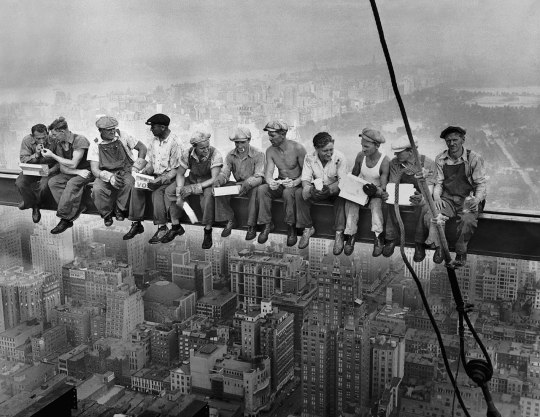
The photo appeared the first in the Sunday photo supplement of the New York Herald Tribune on October 2, 1932.
The photograph was taken on September 20, 1932, on the 69th floor of the RCA Building during the last months of construction. According to archivists, the photograph was in fact prearranged. Although the photograph shows real ironworkers, it is believed that the moment was staged by Rockefeller Center to promote its new skyscraper.
Formerly attributed to "unknown", and often misattributed to Lewis Hine, it was credited to Charles C. Ebbets in 2003. Evidence confirming his authorship held in the Ebbets' Estate archives include original work orders showing invoices to Rockefeller Center for the time period surrounding the photo, letters of recommendation from his work at Rockefeller Center when the photo was taken, a copy of the original article from the NY Herald Tribune when the photo first appeared in 1932 in his own scrapbook of his work, photos from his office in NY taken in 1932 showing the image on a bulletin board display of his work, and a negative of him at work on the site that day.
The movie Men at Lunch traces some of the men to possible Irish origin, and the director reported in 2013 that he planned to follow up other claims from Swedish relatives. The film confirms the identities of two men: Joseph Eckner, third from the left, and Joe Curtis, third from the right, by cross referencing with other pictures taken the same day, on which they were named at the time. The first man from the right has been identified as Slovak worker Gustáv (Gusti) Popovič from the village of Vyšný Slavkov in the Levoča District. Popovič was originally a lumberjack and carpenter. In 1932 he sent his wife Mária (Mariška) a postcard with this photograph on which he wrote, "Don´t you worry, my dear Mariška, as you can see I'm still with bottle. Your Gusti."
Gustáv and Mária's joint grave in the Vyšný Slavkov cemetery is decorated with the picture.
#vavuskapakage#fresh off the boat#constance wu#randall park#hudson yang#history of art#art#tv show quote#tv show#american art#american photography#Whistler's Mother#james mcneill whistler#pop art#victorian art#andy warhol#marilyn monroe#Lunch atop a Skyscraper#Charles C. Ebbets#Charles Clyde Ebbets#american artist#artoftheday#painting#illustration#silkscreen printing#original photographers#photography#photoart#photooftheday
34 notes
·
View notes
Text
Decade
Project: Decade. #Decade
In the mid-1820s, Nicéphore Niépce first managed to fix an image that was captured with a camera, but at least eight hours or even several days of exposure in the camera were required and the earliest results were very crude.
The First Cameras
“The basic concept of photography has been around since about the 5th century B.C.E. It wasn't until an Iraqi scientist developed something called the camera obscura in the 11th century that the art was born.
Even then, the camera did not actually record images, it simply projected them onto another surface. The images were also upside down, though they could be traced to create accurate drawings of real objects such as buildings.
The first camera obscura used a pinhole in a tent to project an image from outside the tent into the darkened area. It was not until the 17th century that the camera obscura became small enough to be portable. Basic lenses to focus the light were also introduced around this time.
The First Permanent Images
Photography, as we know it today, began in the late 1830s in France. Joseph Nicéphore Niépce used a portable camera obscura to expose a pewter plate coated with bitumen to light. This is the first recorded image that did not fade quickly.
Niépce's success led to a number of other experiments and photography progressed very rapidly. Daguerreotypes, emulsion plates, and wet plates were developed almost simultaneously in the mid- to late-1800s.”
Source: https://www.thesprucecrafts.com/brief-history-of-photography-2688527
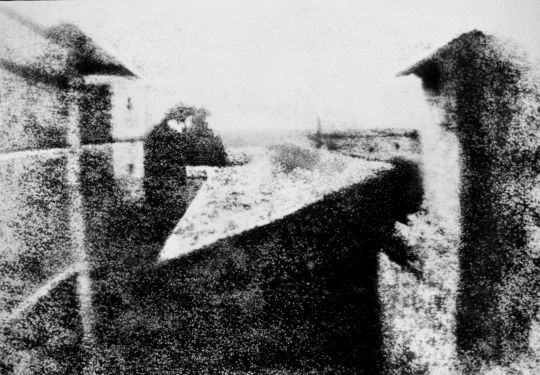
Retouched version of the earliest surviving camera photograph, 1826 or 1827, known as View from the Window at Le Gras
Photography has long been influenced by painting and art.
“The relationship between painting and photography has extended the possibilities of image creation. When photography appeared on the scene, it was supposed to herald the democratization of portraiture (among other genres, like landscapes and still-lifes). Photography gave painting the freedom it needed to burst into the rich fountain of expression it is today. There are many classic and modern painters whom, thanks to their skills with lighting and conceptualization, can serve as valuable guides for today's photographers.”
Johannes Vermeer (1632 – 1675)
Source:https://www.lightstalking.com/8-painters-real-effect-todays-photography-photographers-influenced/
My Decade to research – the 1980’s
Timeline of 1980’s Events
Overview:
“The decade was great socioeconomic change due to advances in technology and a worldwide move away from planned economies and towards laissez-faire capitalism.
As economic deconstruction increased in the developed world, multiple multinational corporations associated with the manufacturing industry relocated into Thailand, Mexico, South Korea, Taiwan, and China. Japan and West Germany saw large economic growth during this decade. The AIDS epidemic became recognized in the 1980s and has since killed an estimated 39 million people (as of 2013).[1] Global warming became well known to the scientific and political community in the 1980s.
The United Kingdom and the United States moved closer to supply-side economic policies beginning a trend towards global instability of international trade that would pick up more steam in the following decade as the fall of the USSR made right wing economic policy more powerful.
The final decade of the Cold War opened with the US-Soviet confrontation continuing largely without any interruption. Superpower tensions escalated rapidly as President Reagan scrapped the policy of détente and adopted a new, much more aggressive stance on the Soviet Union. The world came perilously close to nuclear war for the first time since the Cuban Missile Crisis 20 years earlier, but the second half of the decade saw a dramatic easing of superpower tensions and ultimately the total collapse of Soviet communism.
Developing countries across the world faced economic and social difficulties as they suffered from multiple debt crises in the 1980s, requiring many of these countries to apply for financial assistance from the International Monetary Fund (IMF) and the World Bank. Ethiopia witnessed widespread famine in the mid-1980s during the corrupt rule of Mengistu Haile Mariam, resulting in the country having to depend on foreign aid to provide food to its population and worldwide efforts to address and raise money to help Ethiopians, such as the Live Aid concert in 1985.”
Source:https://en.wikipedia.org/wiki/1980s
Timeline of major events: (from a very American perspective)
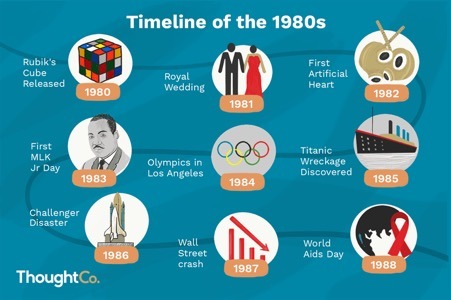
Photography and photographers in the 1980’s
Equipment:
The 80s were a peak time in photography. 35mm cameras were just starting to shift from predominantly mechanical devices into slightly more advanced machines. Having micro-electronic systems at the heart of a camera became the new normal and that made photography easier; new features progressed from more accurate shutter control to program full auto-exposure, to multi-segment light metering systems, to automatic reading of ASA/ISO codes, to integrated motors for advancing and rewinding, and finally AutoFocus (although AF didn’t truly come into its own until the next decade). The dominant manufacturers at the time are sometimes referred to as the ‘Big Five’: Canon, Minolta, Nikon, Olympus, and Pentax. These brands produced the majority of 80s cameras and are now classic models.
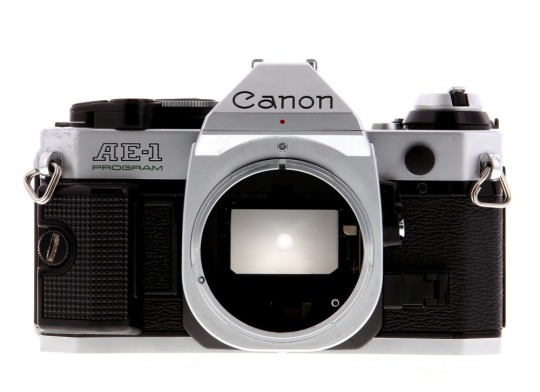
CANON AE-1 PROGRAM
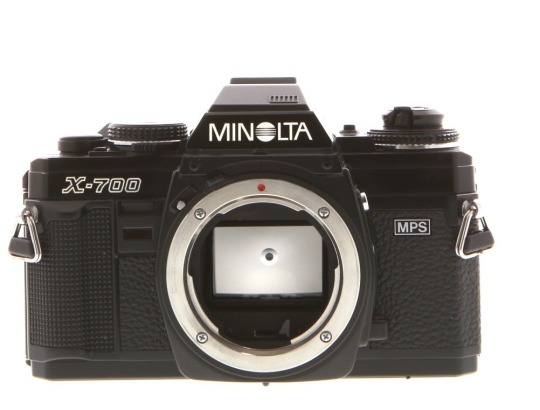
MINOLTA X-700
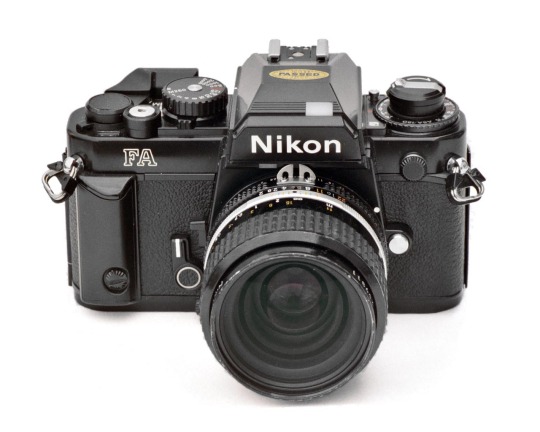
NIKON FA
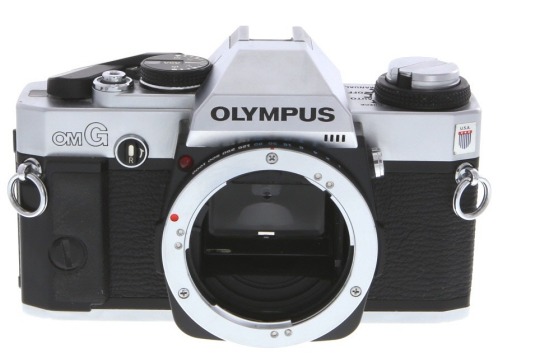
Olympus OMG

Pentax P3
Source: https://www.keh.com/blog/thats-so-80s-cameras-from-the-1980s/
Photographers:
An American perspective of 80′s photography...
“In the ’80s, new wave and hip hop exploded, graffitied subway cars and gritty nightclubs colored New York City, and John Hughes’s tales of teenage angst like Sixteen Candles (1984) and The Breakfast Club (1985) seized the big screen. Meanwhile, an energized, punk-infused youth culture developed within the context of the ongoing sexual liberation that began in the ’60s, the AIDS epidemic, and the conservative leadership of President Ronald Reagan and British Prime Minister Margaret Thatcher. Below are eight photographers who captured the decade’s young people in all their vibrant individuality.”
Source: https://www.artsy.net/article/artsy-editorial-photographers-captured-rebellious-youth-80s
Richard Corman
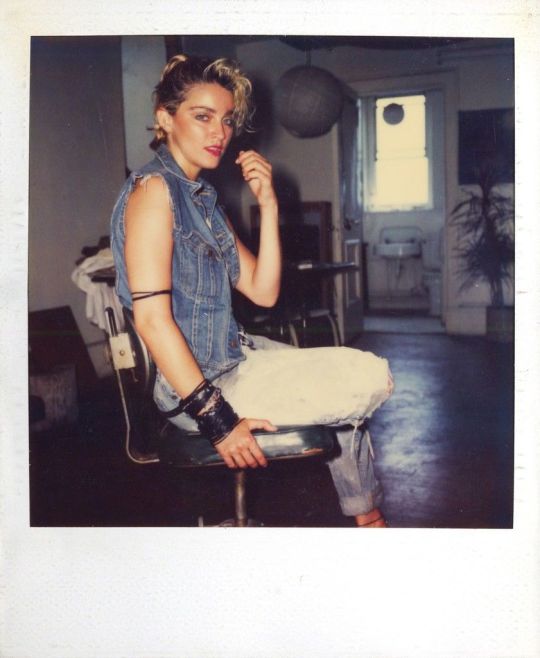
Madonna, Polaroid 4, Milk Gallery
A very British perspective on 80′s street photography...
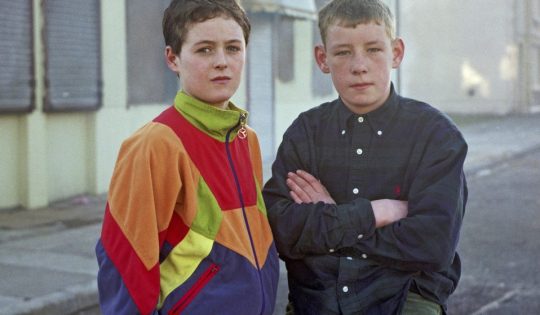
Rob Bremner, Liverpool
The 1980’s are widely regarded as Liverpool’s lowest ebb. A time when work in the city was scarce, alienation from the rest of the country was peaking, and newfangled drugs were tightening their grip on the city’s housing estates.
During this period Rob Bremner, 54 – then a shaggy-haired student from Wick, Scotland – was photographing the region’s inner-city wards, as they came to terms with a Conservative government whose policies appeared to deliberately degrade them.
Source: https://www.huckmag.com/art-and-culture/photography-2/back-in-the-day-photos-of-liverpool-in-the-80s/
The other end of the spectrum - high glamour fashion photography...
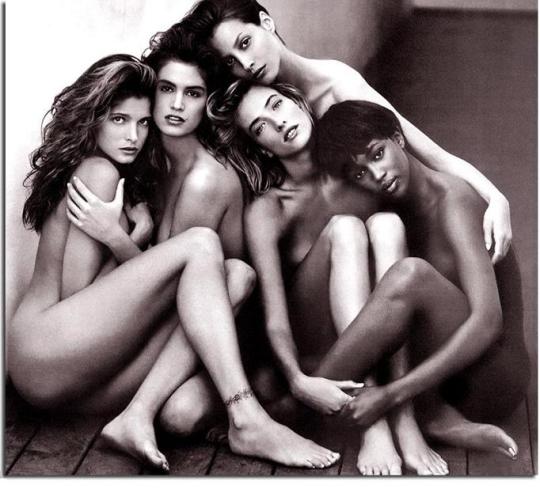
Stephanie,Cindy,Christy,Tatjana & Naomi photographed by Herb Ritts (1989)
“While some of the most creative fashion photography of the 1980s continued to be produced by 'old-timers' like Richard Avedon - see, for instance, his narrative advertising campaign "The Diors,"or his nude shot of Nastassja Kinski entwined with a snake - younger photographers also emerged into the limelight, including: Herb Ritts (1952-2002), best-known for his iconic shot of "Stephanie, Cindy, Christy, Tatjana, Naomi, Hollywood, 1989" which appeared in Rolling Stone Magazine; Bruce Weber (b.1946) who presented a new outlook on masculinity through his photo-shoots for Armani and Calvin Klein, as did Robert Mapplethorpe (1946-89) with his homoerotic shots; and Gian Paolo Barbieri (b.1938), noted for his work for fashion designers Armani, Versace, Dolce & Gabbana, Pomellato, and Giuseppe Zanotti. At the same time, women's independence was emphasized in various settings, by photographers like Denis Piel (b.1944) and Bert Stern (1929-2013).
Controversy, always a handy tool with which to boost flagging commercial fortunes, reared its head as a result of Benetton's fashion campaign, shot by Oliviero Toscani (b.1942). Images included one of a patient dying of AIDS in front of grieving relatives, while others incorporated references to racism, war, religion and the death penalty.
The leading supermodels of 1980s fashion photography included: Gia Marie Carangi, Ines de la Fressange, Cheryl Tiegs, Christie Brinkley, Paulina Porizkova, Brooke Shields, Heather Locklear, Carol Alt, and Elle Macpherson, among others. It was during this decade that supermodels stopped being seen as individuals and started to be regarded as images, just like movie stars. Witness the celebrity party shots taken by fashion photographer Roxanne Lowit (b.1965) of supermodels like Elle Macpherson, Naomi Campbell and others.”
Source: http://www.visual-arts-cork.com/photography/fashion.htm#eighties
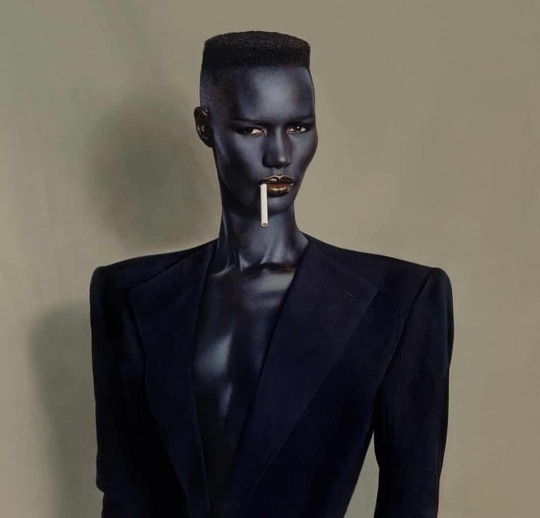
Grace Jones, Jean-Paul Goude, New York (1981)
“I wanted to focus on Grace’s masculinity – to use what other people thought an embarrassment, and turn it around to her advantage. I wanted to create – with her, of course – a new character. It went beyond just a haircut, it was an attitude. It was new and strong and ambiguous. You didn’t know if it was a man trying to be a girl or a girl trying to be a man. It was a revolution. I remember the A&R guys at Island saying, “Are you fucking crazy? This is never going to work.” And of course it did.”
Source: https://www.theguardian.com/artanddesign/2018/aug/01/jean-paul-goude-best-photograph-grace-jones-nightclubbing
4 notes
·
View notes
Text
[Article] “King of the castle”
by Michelle Griffin for The Sydney Morning Herald, first published 21st May 2011
(What follows is a copy/paste of the article then screenshots from the Wayback Machine as the original is no longer available.)
Michelle Griffin joins a legion of Camelot fans beneath the fairytale towers of Chateau de Pierrefonds.
Many castles lay claim to being the original Camelot. The latest home of King Arthur's magical kingdom lies about 90 minutes north-east of Paris, in a glorious stone folly called Chateau de Pierrefonds.
For three months of the year, this imposing grey-stone pile is the location of the BBC series Merlin, which revamps the Arthurian legends as an awkward friendship between arrogant Prince Arthur and his teenage manservant, Merlin, who must keep his magical talents a secret. If, like the program, this castle is not exactly faithful to its mediaeval origins, it hardly matters to the fans who watch the camera crews re-enact battles, jousts and feasts for the fourth series.
They're not filming when my family and I decide to make a pilgrimage to the site of one of our favourite shows. But even without the catering vans blocking the archways and production teams roping off the staterooms, this mad 19th-century vision of the ideal mediaeval castle turns out to be a terrific day trip from the French capital.
"It truly is like the seventh or eighth character on the cast list," actor Anthony Head, who plays cruel King Uther, told website Monsters and Critics. "The stones still look new even though it's a few hundred years old... It's not like a castle that's got bits missing and chunks taken out of it."
Looming above a tiny village in the Oise district, this restored mediaeval stronghold was one of France's favourite romantic ruins long before Napoleon III started rebuilding it in 1857. Cardinal Richelieu ordered its demolition in 1617, after the nobles within backed the wrong duke.
It's the remaining 14th-century twin towers that take our breath away as we walk up the steep hill to the entrance - especially "Charlemagne's tower", a round donjon with a peaked roof that local wisdom says is the inspiration for Walt Disney's Sleeping Beauty.
There has been a castle on this site since the 12th century. It's a strategic location, because invading armies have always marched down the Oise Valley. Julius Caesar fought the Gauls in this region. Joan of Arc fought the English in the surrounding forests and prayed unsuccessfully for victory in the church at nearby Compiegne. On the outskirts of Compiegne, a memorial stands on the abandoned rail line where the armistice was signed on November 11, 1918. In 1940, Hitler made the French sign on his terms in the same rail carriage, which was then destroyed in Berlin.
Eugene Viollet-le-Duc, the architect appointed by Napoleon III in 1857 to restore Pierrefonds, did far more than rebuild the ruined towers and the outer walls. Like the cathedral of Notre Dame, this castle was re-created as a 19th-century dream of the Middle Ages - a riot of gargoyles and arches and long, airy galleries with camera-ready sight lines. Steel girders prop soaring roofs, and walls are painted in intertwined stencils. Viollet-le-Duc died before the job was done and the money ran out when Napoleon III was deposed in 1870 but Pierrefonds still feels ready for its next royal.
A few huts - remnants of Merlin's lower village locations - line the walkway to the moat. The jousts are filmed on a green sward overlooking the valley. Through the enormous arched gateway, with its satisfyingly fierce portcullis, we discover a central courtyard that reminds us not only of the TV series but every Arthurian book illustration. A wide, sun-bleached staircase is fronted by a bronze knight and guarded by snarling griffins. Downspouts have been carved into lizards. A long walkway is decorated with earnest stone knights and demented gargoyles - screaming monkeys, vomiting dragons and a loony five-breasted monster, its jaw unhinged to poke out its curling tongue. This is where Uther and Arthur walk and talk about how best to repel the series' latest invasions. The draughty stateroom on the first floor of the main building hosts art exhibitions but is also the TV location for countless courtly confrontations before the throne.
Climbing the stairs to half-decorated chambers and echoing arched corridors is tremendous fun for anyone who ever read childhood novels about being transported back in time - it speaks as much of Rapunzel or Narnia as Camelot. Every time we lean out a window, flocks of pigeons take off in loops above the castle roofs. Our one regret is that we cannot climb to the very top and peer out between the Lego blocks of the battlements.
FAST FACTS
Getting there
Emirates has a fare to Paris for about $2070 low-season return from Melbourne and Sydney, including tax. You fly to Dubai (14hr), then Paris (7hr 30min).
To get to Chateau de Pierrefonds from Paris by car take the A1 motorway, or go by train to Compiegne, followed by a 20-minute, €20 ($26.60) taxi ride to Pierrefonds; voyages-sncf.com. A bus runs to Pierrefonds from Compiegne twice a day; oise-mobilite.fr.
Visiting there
Chateau de Pierrefonds is open daily from 9.30am to 6pm until September 4 and from 10am-1pm and 2-5.30pm Tuesday to Sunday from September 5 to April 30. Entry is €7, concession €4.50, under 18 free; pierrefonds.monuments-nationaux.fr/en.






1 note
·
View note
Text
youtube
#the machine herald ;; gallery#auditory stimulation ;; music#era :: s1a1#era :: s1a2#era :: s1a3#era :: s2a1#era :: s2a2#era :: s2a3#Youtube
2 notes
·
View notes
Text
can we please take a look at what a photo from the pixel 7 pro looks like with and without google's ai enhancements applied to it.
because ai enhancement in smartphones was probably the first big front for discussing ai's impact on the validity of art and it mostly passed everyone by.
(below the cut)


the photo on the left was taken in the OpenCamera app, which doesn't have access to google's photo processing algorithm and is more representative of what the untouched output from this phone's main camera lens looks like.
the photo on the right was taken with Google Camera, and automatically has google's photo processing algorithm applied to it before it's saved to my photo gallery.
both photos were taken the same distance from the subject, default settings, main camera lens. zoom in and look at the finer details.
it's been half a decade since google and MIT revealed they'd been collaborating on a machine learning model that could be used during image processing to 'improve' photos taken with lower quality optics, like the lenses found on smartphones. the original algorithm, unveiled in 2017, was created using a dataset of 5,000 images taken through a collaboration between Adobe and MIT, and the reception to this AI image processing was heralded as a huge leap for the quality of smartphone photography.
since then, google has touted training its photo processing algorithm on thousands of photos with accurate depictions of human skin tones in order to improve the accuracy of pixel phone users' photos of people with diverse skin tones, but there's been little else said to the public about how the dataset has been improved over the past five years.
most of the tweaks google's algorithm likes to do to images before saving them are based on what it believes the general public wants to see: turn up the contrast, brighten up backlit photo subjects, sharpen text, retain textures on surfaces, sharpen up the image overall, etc.
to me and to most, the photo that has undergone google's ai image processing is objectively better than the one that hasn't. in both instances, the artistic input i had as a photographer was the same: i set up the item, positioned it in the camera frame, put the camera in the right spot, tapped on the subject to focus, and then took the photo.
despite doing no extra work, using no additional skills as a photographer or photo editor, and using the exact same process and equipment, the google camera photo came out significantly improved over the open camera photo. the lighting is artificial, but it's an improvement over opencamera. the texture retention is simulated, but it makes the image look much higher quality than opencamera's. the text on the front of the case being sharpened was a choice the AI made without my input, but it's clearly more legible than in the other photo, and in my opinion makes the photo look better.
that said, i work with photos a lot, and it's obvious to me that google camera puts out an "artificial" looking photo that has been manipulated to improve areas where the original photo might have been weak. despite this, though, the vast majority of people don't even know what to look for; if i were to submit this, or some other photo from this camera to a photography competition, would it be unfair? would i have an unfair advantage over the people who are using their DSLRs and spending twice as long editing by hand in photoshop? what if they use photoshop cc's neural network filters, or the machine learning-powered subject select tool while they're editing? does that level the playing field? it's splitting hairs, it's a losing game, and to the vast majority of people, who could possibly even care?
i really don't think most people realize just how big a role ai processing has played in almost every smartphone photo they've taken over the past several years. with some phones, what you see in the viewfinder already has some ai adjustments applied to it; you're not even seeing a raw feed of what the world looks like on the other side of the lens.
personally, i don't lose sleep over it, and the photographers who do are pretty few and far between at this point.
i think there's value in being an artist who isn't interested in a workflow that involves machine interpretation of your work. there are plenty of instances where i trust my DSLR to take photos over my phone despite all of the extra editing i have to do to make them look presentable, so i get it, but i also think it's unreasonable to look at someone who's making use of ai tools as if they're wrong to do so.
ai-powered smartphone cameras have yet to replace photographers, ai text generation has yet to replace authors and journalists, and ai art generators have yet to replace visual artists.
there may come a day when ai generation tools create works deemed 'good enough' for the least discerning bosses or clients, but with the current rate of progress i don't anticipate a time when machine learning models are able to create with the precision of human intent.
i empathize with people who are worried ai art or text generation is going to put them out of a job someday, but i don't think getting mad at the programmers making the ai generation programs is going to fix the biggest issue, which is that capitalism says we have to work and earn money or else we die
67 notes
·
View notes
Text
4. Yujin Lee & Prima Jalichandra-Sakuntabhai (part 1)
Yujin Lee and Prima Jalichandra-Sakuntabhai discuss Paul Chan’s article, “What Art Is and Where It Belongs,” artistic production and its relationship to capital, making art for (or not for) a Western art audience, their interest in collaborative/process oriented projects, and whether or not one can be free as an artist from the intersecting systems of global capitalism and white supremacy that make up the art world. Read part 2 of their conversation here.

Yujin Lee (YL): Hi, Prima! First of all, thank you so much for accepting my invitation! I see that you received my email with the link to Paul Chan’s article, “What Art Is and Where It Belongs.” I suppose I will start with this obvious question. What is art to you and where do you think it belongs?
Prima Jalichandra-Sakuntabhai (PJ): Hi Yujin, thank you for sharing the Paul Chan text. It was indeed an interesting read! To your question as to “what is art to me and where I think it belongs”, my job as an art handler has deeply affected how I view art. I can no longer see art as a product of a singular mind but rather, an object that exists in relation to multiple networks. Paul Chan is generous in giving art the definition of a “more than” an object by the way that it expresses what an object desires to be. I would argue that art is only “more than” an object because it’s value is not intrinsic to its material properties and use-value but the cultural value assigned to it by a number of actors. When I was in undergrad I came across this book called, Worlds of Art (Les Mondes de l’Art) by Howard S. Becker. Anyway, he was one of the first authors to place art and artistic production in a chain of labour production from administrative works of post-production and marketing to intellectual works from universities and curatorial work. That vision of art is more true to me in my daily life than the art that is heralded for its poignant inquiry into humankind’s psyche and advancement of what we call “civilization”. So the simple answer to your question may be that art belongs to capital and serves those who can afford its production and consumption. But at the same time, while I serve as a clog in this system, I also want to make an art that can exist outside of the system and truly be moments of disconcert with the real. My current show is up at a gallery that used to be a storefront in a shopping plaza in Chinatown, Los Angeles. The interface with a non-art audience is inevitable. The projections attracted attention and the occasional passer-bys waiting to pick up their food would stop and talk to me. But the conversations remained fairly surface. None of them have yet made an appointment to intentionally see the work. Not to mention the heightened tensions caused by art’s complicity in gentrification. So, even in a public-facing space, art can only rely on its existing structures and those who already have access to them.
Since you work a lot with the public and collaborations, I wonder how the experience has been for you and whether you believe art can belong outside of the art world itself?

Prima Jalichandra-Sakuntabhai, Chloropsis Aurifrons Pridii, 2021, performance and multi-media installation, 2 video projectors, 2 overhead projectors, transparencies, colour filter, printed black and white images on photocopy paper, books
YL: I completely agree with everything you said about the complex networks that build up a work of art (and the artist’s career). Come to think of it, when has art ever been outside of that system? One example comes to mind that relates to how Paul Chan began and ended his article. Chan begins with a very “kitsch” painting that he purchased for thirty dollars in the streets of New York and an unexpected challenge in finding the right place to hang it in his home. And he ends the article with, “For art to become art now, it must feel perfectly at home, nowhere.” This beginning and ending reminds me of the Korean shaman paintings (portraits of the indigenous gods). Even though the tradition goes far back in history, not many of these paintings remain. They were either burned or buried because people believed that the painting is a physical dwelling (or a seat) for a particular god served by a particular shaman. In most cases, the artist is also unknown and unimportant. Moreover, up until the late 80s, art collectors refused to collect shaman paintings as they are not merely powerful paintings (as an art object) but empowered paintings (as sites of divine presence). Despite it all, if it somehow falls into a collector or enters the museum, it is believed to become what Marx called the commodity fetish, losing its power, thus losing its value. In this case, the art object, artist, and collector all have no place! This may be why shaman paintings have not been considered “art” for so long by its creators, users, and admirers. So for me, it’s not a matter of whether art can or cannot belong outside the “art world,” but that “it must feel perfectly at home, nowhere,” or that it must feel perfectly at home, everywhere. I test this theory by experimenting with process-oriented, collaborative, performance and relational art.
I watched the video documentation of the performative lecture installation that you’ve mentioned, Chloropsis Aurifrons Pridii, at The Fulcrum Press. The collage of your voice with the light and shadow of texts and images created by multiple projectors choreographed by the subtle gestures of your hands… It was a sensorial and immersive experience, even through my computer monitor. The occasional sound of the machines turning on and off took me in and out of this poetic narrative. I was also compelled by the intricately untangled individual journeys of your family members crossing three generations, and your re-interpretation of the overarching macro history that wolves together three continents. The most memorable moment was when you said, “... Both view history as driven by cycles of reincarnations. Within one body, one consciousness, are contained centuries of all earthly desires, unquenched. History thus progresses as a movement of return. For the last five years, I face the Pacific and the fear of a return.”
Having said that, I wonder why contemporary art often appears to be disparate from the rest of the world. Sometimes even alienating and elitist. Judith Butler actually defends this position quite eloquently:
“Who devises the protocols of ‘clarity’ and whose interests do they serve? What is foreclosed by the insistence on parochial standards of transparency as requisite for all communication? What does ‘transparency’ keep obscure?”
This statement may sound like art gibberish to the non-art audience and support your disappointment of the disinterest displayed by the non-art audience in Chinatown. But I wonder, what does it mean to desire the interests of the “non-art audience”?

PJ: First of all, yes to process art works! I think our two approaches to art practice staunchingly demarcate us from “the commodity fetish” that most high art/internationally-recognized art ends up becoming by the very fact that we care less about the end product and more about the creative process themselves. The process can take shape as a form of knowledge or a set of techniques that in my case, takes on a certain shade based on my personal narrative. But taken up by someone else, the combination of voice, body movements and layering of images that you noted, would express something else entirely. That is what I am interested in in achieving: rather than creating an original product, I want to redefine techniques and processes of thought. I think the relationality and collaboration in your work that I’ve seen at VER and what you continue to do at your residency in Jeju strive for a similar balance between the creation of processes and the specificity of the people you engage with.
This reflects the other side of our art practice: although it is defiant of consumerist art, it is still bound to the Western art canon. Even a working against or criticism of Western art canon asks the audience to be aware of the canon to understand our respective positions. I respond strongly to you raising the example of the Korean shaman paintings (of which I know nothing of!) as being uncollectable and therefore, not considered art. In this case, its power operates in a culture that is closer to the non-art audience. It doesn’t need to invent value for itself but its symbolic code is embedded in the culture that receives it.
That is why I am saddened by not being able to touch the “non-art audience”. I believe that I envy the power of the shaman paintings, a power that can touch anyone without necessary prior knowledge. That is what I lament in operating in the current art world that I am in. At the same time, I do deeply agree with you that the demand for clarity and the parochial is a form of holding back of thought and the need to plunge in the mystery that is sometimes too specific for the artist themselves to put words to. That is perhaps why I still value art over other forms of knowledge: art can give shape to what is previously unknown. I also don’t mean to juxtapose the shaman paintings versus the inaccessibility of high art, as if one holds more intellectual value than the other. What I simply want to highlight is the different levels of reception that each form allows for.
YL: It’s true that the non-art audience (who may not necessarily understand the painting’s aesthetic value nor its symbolic meaning) are likely to succumb to the power of shaman paintings because of its deep-rooted history that vibrates within the culture. Do you know about the Swedish artist and mystic, Hilma af Klint? I think she didn’t give two cents about the art or non-art audience. Af Klint considered her experimental paintings (the first Western abstract art known to date) too avant-garde for her contemporaries and rarely exhibited them in public in her lifetime. Meanwhile, her so-called Theosophical art, which was heavily influenced by Buddhism and Hinduism, interestingly brings us back to the Korean shaman paintings. Before creating a shaman painting, one is to take a good bath, wear clean new clothes and oftentimes chant a prayer. Af Klint did something similar. Before starting a new series of paintings, she dedicated many months of “purification” by adjusting her lifestyle, like practicing vegetarianism. It may sound like a frivolous formality, but it demonstrates a belief on how the creator’s (artist’s) personal life cannot be severed from their creation (art), even if the admirers (public) may never know or care about the creator to begin with.
I’d like to go to your comment on how art “can give shape to what is previously unknown.” Chan also states that “in art, the only ideas worth realizing are the truly untenable ones.” I seriously weighed this concept (of art giving shape to obscurity) during my exhibition in Bangkok at the end of 2019, especially through the work you mentioned earlier, Drawing Conversation 2.0, a series of collaborative live automatic drawing performances created with local Thai artists. The obscurity for me at the time was the uncomfortable reality of having a solo show at a place where I did not understand its native language, culture, nor history.
A smaller room attached to the main gallery was dedicated for this work. The walls were painted black, and the floor laid with a dark grey carpet. A square table (around 30 cm in height) was placed in the center of the room where a blank sheet of paper covered its entire surface. A large scale drawing titled, In the beginning was___, was hung along with 5 other blank sheets of papers ready to be conversed upon. Drawing materials such as graphite, charcoal, eraser, and pen (no colors) were provided. For each session, a local artist was invited to create a drawing with me in silence for 108 minutes. A timer was set on my phone. The audience could freely enter and exit the space, sit, stand, or walk around us. The first ten minutes or so felt highly performative. But as more of our marks, gestures, breaths, and bodily heat crisscrossed, I experienced a kind of a (collective) trance. And when the timer went off and broke the silence of the room, the familiar ringtone of an iPhone sounded like the Korean shaman bell, bringing everybody in the room back to the present time and space. I think maybe this was my closest attempt in creating an “empowered painting.”

Yujin Lee, Drawing Conversation 2.0, Nov. 29, 2019, collaborative live drawing performance with artist Dujdao Vadhanapakorn, 108 minutes, Gallery VER
YL: Back to Chan… He asserts that “art and life would rather belong to the world than be free in it.” That is a bleak outlook for art, don’t you think? So, my question is, can we imagine art to be free in the current world (of capitalism)? I wonder what your thoughts are on this last point, and could you expand your thoughts on “art giving shape to the unknown” in relation to how you use language/text in your work?
PJ: Two big questions! [laughter]. I think it is a good question because we’re working towards agreeing that art is more often than not, not free in capitalism but can there be instances where they are…
YL: I thought that the last part of his text was interesting because when he’s saying “art and life would rather belong to the world,” it has a negative connotation... contrasting to what follows, “rather than be free in it.” Also you would think that he meant to say, “be free from it,” suggesting an escape from the world of inequity. But he’s sort of saying even within the system, art can be free inside of it, right? I thought that was an interesting, nuanced statement, and I want to pose this question to you, since you are still in the system, the LA art scene.
PJ: Are you saying that you’re not part of a scene because you are in Jeju?
YL: [laughing hard] That’s how I felt when I moved to Jeju, but with COVID I don’t think that’s true anymore because the internet in some ways amplifies the presence of the international art scene.
PJ: I think art has always been in network and in communication across borders and that capital gives more value to the kind of art that travels or is part of the international scene. LA or New York may have a very specific local scene but these major cities give the impression that if you’re part of their local scene, you’re somewhat seen internationally. So I think that art still depends on this kind of network. But the thing that is different with COVID is that people are more proactive in participating across countries and timezones.
YL: Yeah, that’s actually what I mean. I thought I left, by relocating to an island, a countryside, but COVID definitely brought me back to the network.

Yujin Lee, Painting Conversation, 2021, collaborative drawing performance with artist Jo Ahra, paintings completed over 4 sessions (March 19th, 21st, 23rd, 28th), Next Door to the Museum Jeju Artist Residency completed painting used as a costume for an improvisational dance video (work in process)
PJ: I want to also argue that maybe even if our locations are specific, that doesn’t mean that we’re not part of a larger network that has formed us.
Whether you like it or not, your context will always be informed by the experience you had in New York.
YL: You’re right. I thought, ‘physically leaving New York= leaving the art world.’ But the reality is, like you said, my experience as an artist is based on my time in New York. So, I’m probably going to carry that with me. So back to my questions on Chan’s statement… We’re all part of this world that is not very equitable... How can we be part of it, yet “be free in it?”
PJ: I want to believe that there is some sort of freedom. When you give away a certain part of the bargain and that bargain being monetary or investment by some sort of institution to give value to your art, to me, by abandoning that, I feel much more free. And I’m able to have full ownership of decisions around my work, which would not be the case if I was trying to respond to a certain expectation.

Prima Jalichandra-Sakuntabhai, Seven Springs, 2019, Collaboration with Chris McKelway, 2 violins, 2 overhead projectors, images printed on transparencies, colour filters

Yujin Lee is a Jeju-based visual artist working with drawings, performances, videos, and audience-participatory projects. Interested in the Buddhist concept of yuanqi (interdependency), Lee have pursued collaborative projects with artists Emi Hariyama (108 Bows, 2013), Nicole Won Hee Maloof (Same/Difference, 2015), Aracha Cholitgul (im_there_r_u_here, 2020~ongoing), and Jo Ahra (Untitled, 2021~ongoing). Since 2019, she has been running an alternative artist residency at her farmhouse, Next Door to the Museum Jeju. Lee received her MFA in printmaking from Columbia University and a BFA in painting from Cornell University.
leeyujin.com @jejuanarchist
Prima Jalichandra-Sakuntabhai is a transdisciplinary artist, working across performance, video and installation, based in Los Angeles. Born in Thailand in 1989, they were raised in Europe before moving to the US in 2011. They received their Visual Arts Degree from the Ecole des Beaux Arts de Nantes Metropole and a License in Film Studies at the Sorbonne Nouvelle-Paris 3. They earned BFA at the School of the Arts Institute of Chicago and MFA at the California College of the Arts, in San Francisco. Featured in the 2015 Arizona Biennial at the Tucson Museum of Art, Arizona. Recipient of the SOMA Summer Award, Mexico City and the emi kuriyama spirit award.
Recent projects include: Fieldnotes for Useful Light, The Prelinger Library (San Francisco), Irrational Exhibits 11: Place-Making and Social Memory, Track 16 (LA) and The Anthropologist As Hero, in collaboration with Linda Franke, Justine Melford-Colegate and Jessica Hyatt, PAM Residencies (LA), Chloropsis Aurifrons Pridii, Fulcrum Press (LA). They curated the MAHA Pavillion for the Bangkok Biennial 2020.
www.primasakuntabhai.com @prima_jalichndrsakntbhai
0 notes
Text
AUGUST LISTENINGS #1: Electric Masada - At the Mountains of Madness

Genres: avant-garde jazz, jazz fusion, avant-garde metal
"From the unreal lead us to the real" "From darkness lead us to light" "From death unto immortality" In the traditional Hindu triumvirate, there are 3 gods who compose the reality of which we exist, the world in which soil binds us, in which havoc has been ravaged across an arid visage, carved out bones of the coming end. Vishnu, Brahma, and Shiva; the respective gods of creation, upkeep, and destruction. Through Vishnu we are beheld creation, the birth of stars in the bloodied eye of a beheld moon, a crying child held warmly in the blood of that which summoned it. Through Brahma we remain and live out the lives designed for us by beyond figures we cannot comprehend, inevitability in the chasms of flame come to cleanse. And through Shiva, we destroy, we maim, we rend, slaughter, take lives in a flash of what creates them, all crawling through an ashen field towards solemnity in death. This is the universe as known, from the individual atoms weaved together to the overwhelming conclusion of nothingness beyond that which our narrow minded eyes can see. Beings holding the power to conjure, sustain, and destroy at any given moment, calamity draped in the veneer of control That channeling of awe-inspiring power, rending life ablaze in the consciousness of figures beyond us, is the exact coursing force Electric Masada have conjured in spades of abyssal surging tides through this utter monolith of a live set. At an austerely crushing length of 2 hours and 38 minutes, the birth and decay of reality is set into musical composition through a rogues gallery of driven instrumentation all heralded by one John Zorn, an augury to a divine conscience not stated by god nor griot. Elements of avant-garde jazz, avant-garde metal, thrash metal at points, electronic ambience and drone, and a general fusion of elements all guided by Zorn’s illustrious alto sax to guide some listeners into the divine being of stasis in which your soul is rendered null by the fires of Sinai. The rendered bloodied corpse of angels gutted in the black sun is made manifest over and over on many cuts throughout the span of this album. Lest that be the fiery annals of death conjured on cuts like Metal Tov and Idalah-Abal, feeling less like jazz fusions and more like raging pieces of flame with the elements of jazz felt within that surface. Or perhaps it might remain in the ditches of the damned on the quieter, meditative pieces, waxing visions of the wake of barren life given a heart yet not bound by shape, standouts such as both versions of Karaim led by sax and bass in the former, and electric washes of guitar in the latter. Maybe it comes in the form of lush, psychedelic texturing that causes a soul to coalesce out of its skeletal form into a heaping mass, winding and gifted life, such as is found in the 2nd rendition of Kedem. Grooving bass and lulling drums give wake to twanged out, tinged guitarwork that simply mesmerizes you into a graving dirge of silence, face to face with the Devil and God raged against one another to the foraging tides of bloody conquest. Every individual aspect of this album combines in this oceanic wash of atonal Hell and prideful Heaven, the creation, sustainment, and subsequent destruction/revival of itself, an ouroboros of utter syncopation, of wretched love torn through joyous hate Renewal in death is the simple essence of what this album truly seeks to conjure and capture, and in that 2 hour and 38 minute span, there was not a single element that didn’t enrapture me in some way shape or form. Every individual piece of this album simply screams godliness, it is that lordly hallowing choir found in the ascendant piece of golden sky touched by holiness. And on that same coin, it is that piece of obsidian and brimstone found in the depths of flame soaked agony, chained souls damned to eternal torment in the machinations of their own sins. This album breathes in every breath of calamity, of godsends, of havoc amongst heralding. If the utter annihilation of the world is certain, if one day the collective fate of all those placed in this span of abyssal seas are to be washed in the destruction of the stars which gave us life, it is this album which serves as the apostate to our measly end Gifted in life, taken in death, forever bound, never free
10/10
Fav tracks: Lilin, Metal Tov, Karaim (standout), Hath-Arob, Abidan, Idalah-Abar, Yatzar, Tekufah, Abidan pt. 2 (2nd standout), Karaim pt. 2, Kedem pt. 2 Least fav track: N/A lol
0 notes